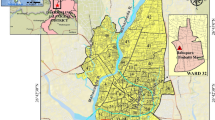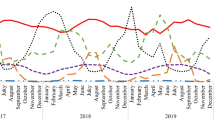Abstract
With the concentration of air pollutants increasing, air pollution has many hazards to the human body. Meteorology is the main factor affecting the diffusion of air pollutants. Studying the dynamic connection between them can provide references for the construction of urban air environment. In this research study, data from meteorological factors (temperature, humidity, wind speed, and rainfall) and air pollutants (PM2.5, PM10, SO2, CO, O3, and NO2) were collected in 2018 from the areas of Zhongshan, Shilin, and Yangmingshan of Taipei City. The Granger causality test was used to analyze the intrinsic dynamic relationship between meteorological factors and Air Quality Index (AQI). The results showed that: (1) the overall level of AQI in Taipei was good, and the main pollutant that contributed to AQI was PM2.5. (2) The range of AQI values in the three study areas were Zhongshan (downtown) > Shilin (suburbs) > Yangmingshan (outskirts). (3) In downtown Zhongshan, temperature and humidity were the Granger cause of AQI; in the suburbs of Shilin, humidity, and wind speed were the Granger cause of AQI; in the outskirts of Yangmingshan, humidity was the Granger cause of AQI. (4) The air pollution of Taipei was found to be mainly a process of self-accumulation and self-diffusion. The self-accumulation effect of AQI was more than 70%. Once the diffusion condition of air pollution deteriorated, it formed air pollution. (5) Wind speed was the main meteorological factor affecting AQI in downtown Zhongshan and the suburbs of Shilin, while the AQI in the outskirts of Yangmingshan was mainly affected by humidity. In the construction of urban air environment, the emission of air pollutants should be controlled and reduced, the construction of urban ventilation system should be strengthened, and the layout of urban space should be rationally planned to create a better urban air environment.







Similar content being viewed by others
References
Baccarelli, A. (2009). Breathe deeply into your genes! Genetic variants and air pollution effects. American Journal of Respiratory and Critical Care Medicine, 179(6), 431–432.
Bottalico, F., et al. (2016). Air pollution removal by green infrastructures and urban forests in the city of florence. Agriculture and Agricultural Science Procedia, 8, 243–251.
Brauer, M., et al. (2002). Air pollution from traffic and the development of respiratory infections and asthmatic and allergic symptoms in children. American Journal of Respiratory and Critical Care Medicine, 166(8), 1092–1098.
Brauer, M., et al. (2016). Ambient air pollution exposure estimation for the global burden of disease 2013. Environmental Science and Technology, 50(1), 79–88.
Brook, R. D., et al. (2010). Particulate matter air pollution and cardiovascular disease. Circulation, 121(21), 2331–2378.
Cheng, S., Li, J., Feng, B., Jin, Y., & Hao, R. (2007). A gaussian-box modeling approach for urban air quality management in a Northern Chinese City—II. Pollutant emission abatement. Water, Air, and Soil pollution, 178(1–4), 15–36.
Chiang, T., Yuan, T., Shie, R., Chen, C., & Chan, C. (2016). Increased incidence of allergic rhinitis, bronchitis and asthma, in children living near a petrochemical complex with SO2 pollution. Environment International, 96, 1–7.
Cohen, A., Brauer, M., Burnett, R., Anderson, H., & Frostad, J. (2017). Estimates and 25-year trends of the global burden of disease attributable to ambient air pollution: An analysis of data from the global burden of diseases study 2015. Lancet, 389(10082), 1907–1918.
Cowan, W. N., Chang, T., Inglesi-Lotz, R., & Gupta, R. (2014). The nexus of electricity consumption, economic growth and CO2 emissions in the BRICS countries. Energy Policy, 66, 359–368.
Deshmukh, P., et al. (2019). The effects of roadside vegetation characteristics on local, near-road air quality. Air Quality, Atmosphere and Health, 12(3), 259–270.
Dominici, F., et al. (2006). Fine particulate air pollution and hospital admission for cardiovascular and respiratory diseases. JAMA-Journal of the American Medical Association, 10(295), 1127–1134.
Douglas, A. N. J., Irga, P. J., & Torpy, F. R. (2019). Determining broad scale associations between air pollutants and urban forestry: A novel multifaceted methodological approach. Environmental Pollution, 247, 474–481.
Fang, C., Liu, H., Li, G., Sun, D., & Miao, Z. (2015). Estimating the impact of urbanization on air quality in china using spatial regression models. Sustainability, 7(11), 15570–15592.
Fu, W., et al. (2018). Spatial and temporal variations of six criteria air pollutants in Fujian Province, China. International Journal of Environmental Research and Public Health, 15(12), 2846.
GaWC. (2018). The world according to GaWC 2016. [EB/OL]. https://www.lboro.ac.uk/gawc/world2016t.html.
Ghosh, R., et al. (2016). Air pollution and childhood bronchitis: Interaction with xenobiotic, immune regulatory and DNA repair genes. Environment International, 87, 94–100.
Granger, C. (1969). Investigating causal relations by econometric models and cross-spectral methods. Econometrica, 37(3), 424–438.
Group T. Y. E. (2018). Taipei yearbook 2017. Taipei: Taipei City Government.
Gu, K., Qiao, J., & Lin, W. (2018). Recurrent air quality predictor based on meteorology- and pollution-related factors. IEEE Transactions on Industrial Informatics, 14(9), 3946–3955.
Hien, P., Bac, V., Tham, H., Nhan, D., & Vinh, L. (2002). Influence of meteorological conditions on PM2.5 and PM2.5 10 concentrations during the monsoon season in Hanoi, Vietnam. Atmospheric Environment, 36(21), 3473–3484.
Huang, K., et al. (2012). Impact of anthropogenic emission on air quality over a megacit—Revealed from an intensive atmospheric campaign during the Chinese Spring Festival. Atmospheric Chemistry and Physics, 12(23), 11631–11645.
Ishikawa, H., et al. (2006). Genotoxic damage in female residents exposed to environmental air pollution in Shenyang city, China. Cancer Letters, 240(1), 29–35.
Jalil, A., & Mahmud, S. F. (2009). Environment Kuznets curve for CO2 emissions: A cointegration analysis for China. Energy Policy, 37(12), 5167–5172.
Janhäll, S. (2015). Review on urban vegetation and particle air pollution—Deposition and dispersion. Atmospheric Environment, 105, 130–137.
Ji, X., Yao, Y., & Long, X. (2018). What causes PM2.5 pollution? Cross-economy empirical analysis from socioeconomic perspective. Energy Policy, 119, 458–472.
Jiang, P., Yang, J., Huang, C., & Liu, H. (2018). The contribution of socioeconomic factors to PM2.5 pollution in urban China. Environmental Pollution, 233, 977–985.
Lelieveld, J., Evans, J. S., Fnais, M., Giannadaki, D., & Pozzer, A. (2015). The contribution of outdoor air pollution sources to premature mortality on a global scale. Nature, 525(7569), 367–371.
Lelieveld, J., Haines, A., & Pozzer, A. (2018). Age-dependent health risk from ambient air pollution: A modelling and data analysis of childhood mortality in middle-income and low-income countries. Lancet Planet Health, 2(7), e292–e300.
Lev, B., Petrovits, C., & Radhakrishnan, S. (2009). Is doing good good for you? How corporate charitable contributions enhance revenue growth. Strategic Management Journal, 31(2), 182–200.
Meng, X., & Han, J. (2018). Roads, economy, population density, and CO2: A city-scaled causality analysis. Resources, Conservation and Recycling, 128, 508–515.
Newby, D. E., et al. (2015). Expert position paper on air pollution and cardiovascular disease. European Heart Journal, 36(2), 83–93.
Ohio, 2018. National Ambient Air Quality Standards (NAAQS)—Attainment status.
Pearce, J. L., Beringer, J., Nicholls, N., Hyndman, R. J., & Tapper, N. J. (2011). Quantifying the influence of local meteorology on air quality using generalized additive models. Atmospheric Environment, 45(6), 1328–1336.
Pope, C., et al. (2002). Lung cancer, cardiopulmonary mortality, and long-term exposure to fine particulate air pollution. JAMA-Journal of the American medical Association, 287(9), 1132–1141.
Raaschou-Nielsen, O., et al. (2013). Air pollution and lung cancer incidence in 17 European cohorts: Prospective analyses from the European Study of Cohorts for Air Pollution Effects (ESCAPE). Lancet Oncology, 14(9), 813–822.
Ramponi, R., Blocken, B., de Coo, L. B., & Janssen, W. D. (2015). CFD simulation of outdoor ventilation of generic urban configurations with different urban densities and equal and unequal street widths. Building and Environment, 92, 152–166.
Ramsey, N. R., Klein, P. M., & Moore, B. (2014). The impact of meteorological parameters on urban air quality. Atmospheric Environment, 86, 58–67.
Shahbaz, M., Khan, S., & Tahir, M. I. (2013). The dynamic links between energy consumption, economic growth, financial development and trade in China: Fresh evidence from multivariate framework analysis. Energy Economics, 40, 8–21.
Squizzato, S., & Masiol, M. (2015). Application of meteorology-based methods to determine local and external contributions to particulate matter pollution: A case study in Venice (Italy). Atmospheric Environment, 119, 69–81.
Tang, C. F., & Tan, E. C. (2015). Does tourism effectively stimulate Malaysia’s economic growth? Tourism Management, 46, 158–163.
Tao, H., et al. (2018). Impacts of land use and land cover change on regional meteorology and air quality over the Beijing–Tianjin–Hebei region, China. Atmospheric Environment, 189, 9–21.
Topcu, S., Incecik, S., & Unal, Y. S. (2003). Research articles the influence of meteorological conditions and stringent emission control on high TSP episodes in Istanbul. Environmental Science and Pollution Research, 10(1), 24–32.
Tsai, H., et al. (2012). Influences of fireworks on chemical characteristics of atmospheric fine and coarse particles during Taiwan’s Lantern Festival. Atmospheric Environment, 62, 256–264.
Wang, Y., Zhuang, G., Xu, C., & An, Z. (2007). The air pollution caused by the burning of fireworks during the lantern festival in Beijing. Atmospheric Environment, 41(2), 417–431.
Wang, X., et al. (2018). Responses of PM2.5 pollution to urbanization in China. Energy Policy, 123, 602–610.
Wang, P., et al. (2019). Responses of PM2.5 and O3 concentrations to changes of meteorology and emissions in China. Science of the Total Environment, 662, 297–306.
Ward-Caviness, C. K. (2019). A review of gene-by-air pollution interactions for cardiovascular disease, risk factors, and biomarkers. Human Genetics, 138(6), 547–561.
Xia, T., Wang, J., Song, K., & Da, L. (2014). Variations in air quality during rapid urbanization in Shanghai, China. Landscape and Ecological Engineering, 10(1), 181–190.
Yao, L., et al. (2019). The effects of firework regulation on air quality and public health during the Chinese Spring Festival from 2013 to 2017 in a Chinese megacity. Environment International, 126, 96–106.
Yu, X. J., & Ng, C. N. (2007). Spatial and temporal dynamics of urban sprawl along two urban–rural transects: A case study of Guangzhou, China. Landscape and Urban Planning, 79(1), 96–109.
Yuan, C., & Ng, E. (2012). Building porosity for better urban ventilation in high-density cities—A computational parametric study. Building and Environment, 50, 176–189.
Zhang, Y. (2019). Dynamic effect analysis of meteorological conditions on air pollution: A case study from Beijing. Science of the Total Environment, 684, 178–185.
Zhang, H., Wang, Y., Hu, J., Ying, Q., & Hu, X. (2015). Relationships between meteorological parameters and criteria air pollutants in three megacities in China. Environmental Research, 140, 242–254.
Zhu, Z., Wang, G., & Dong, J. (2019). Correlation analysis between land use/cover change and air pollutants—A case study in Wuyishan City. Energies, 12(13), 2545.
Acknowledgements
The research of the first author is supported by the Fujian University of Technology (JAT190426; GY-Z19093).
Author information
Authors and Affiliations
Corresponding author
Additional information
Publisher's Note
Springer Nature remains neutral with regard to jurisdictional claims in published maps and institutional affiliations.
Zhipeng Zhu and Yuxuan Qiao are co-first author.
Rights and permissions
About this article
Cite this article
Zhu, Z., Qiao, Y., Liu, Q. et al. The impact of meteorological conditions on Air Quality Index under different urbanization gradients: a case from Taipei. Environ Dev Sustain 23, 3994–4010 (2021). https://doi.org/10.1007/s10668-020-00753-7
Received:
Accepted:
Published:
Issue Date:
DOI: https://doi.org/10.1007/s10668-020-00753-7




